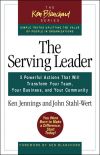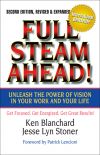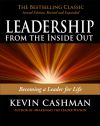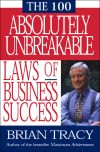Правообладателям!
Представленный фрагмент книги размещен по согласованию с распространителем легального контента ООО "ЛитРес" (не более 20% исходного текста). Если вы считаете, что размещение материала нарушает ваши или чьи-либо права, то сообщите нам об этом.Читателям!
Оплатили, но не знаете что делать дальше?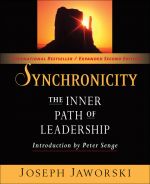
Текст бизнес-книги "Synchronicity. The Inner Path of Leadership"
Автор книги: Joseph Jaworski
Раздел: Зарубежная деловая литература, Бизнес-книги
Возрастные ограничения: +12
Текущая страница: 1 (всего у книги 2 страниц)
JOSEPH JAWORSKI
Synchronicity
Praise for Synchronicity
“A deeply personal and moving narrative that opens up new vistas on compassion, commitment, and connectedness – and hence on leadership.”
– James MacGregor Burns, Pulitzer Prize–winning presidential biographer and Woodrow Wilson Professor of Government, Emeritus, Williams College
“An insightful, profound, and readable contribution to understanding the personal side of leadership.”
– Rosabeth Moss Kanter, Ernest L. Arbuckle Professor of Business Administration, Harvard Business School, and author of SuperCorp
“An unusually thoughtful exploration of the ‘inner’ aspects of leadership, particularly in the business arena, surfaces in Joseph Jaworski’s Synchronicity. Eschewing easy answers and ten-point plans to success, presenting the insights he has garnered from forward-looking thinkers including David Bohm and Rupert Sheldrake, Jaworski offers a searching and wise brief that deserves to be read in board-rooms everywhere.”
– Publishers Weekly
“Synchronicity is an intensely personal and compelling book. As I reeled from Jaguars to mountain-tops to oil companies and a rare window on history, I was grateful that Joe Jaworski let us travel with him on ‘the inner path of leadership.’”
– Frances Hesselbein, President and CEO, Leader to Leader Institute
“From seemingly simple early chords, this book develops into a prophetic symphony by its conclusion.”
– M. Scott Peck, author of The Road Less Traveled
“Synchronicity is a book that anyone serious about leadership will have to read.”
– Peter Senge, author of The Fifth Discipline
“Synchronicity illustrates that leadership is about the release of human possibilities, about enabling others to break free of limits – created organizationally or self-imposed. Although this book describes the author’s personal journey, it contains profound messages about organizational learning and effectiveness.”
– Phil Carroll, President and CEO Emeritus, Shell Oil Company
“Written from the heart as well as the head, Synchronicity is the story of one man’s journey toward the place we all must go in the century ahead. Jaworski’s life demonstrates that the immense cultural and institutional change that a livable future demands can begin anytime, anywhere, in anyone, even those who have benefited greatly from the old order of things.”
– Dee W. Hock, founder and President and CEO Emeritus, Visa International
“Jaworski’s personal search for insight and inspiration is told so compellingly that the reader hardly notices how deep is the philosophy of leadership it conveys – and how broadly relevant to leaders in every domain.”
– Harlan Cleveland, former President, World Academy of Art and Science
“I’ve spent my life writing about a new way to think and to be. Joe Jaworski has spent his living it. His deeply personal vision of Servant Leadership, nurtured by a courageous openness to love, to pain, and to his own and others’ experience, is told with a profound simplicity. Synchronicity touched deeply both my head and my heart.”
– Danah Zohar, coauthor of Spiritual Capital
“No other book is like this one. Its gripping life stories punctuate a how-to on managing toward ‘predictable miracles’ by exploring your ‘cubic centimeters of chance.’ What a wake-up call!”
– Tom Brown’s Top Ten Business Books of 1996
“Joseph Jaworski pinpoints the astonishing encounters that manifested in his life when he followed his inner compass. Wise guides rose spontaneously; fate cleared blockages; love was caught in an airport passing; even an ermine communed eye to eye. Jaworski’s life story teaches us how to recognize and respond to our own moments of inner knowing and how these personal shifts can reverberate in the world.”
– Lois Farfel Stark, American Leadership Forum Fellow and President, Stark Productions, Inc.
TO MY FATHER
WHO LED BY EXAMPLE
PREFACE TO THE SECOND EDITION
Since the publication of the first edition of Synchronicity, I’ve been searching for the principles that lie at the heart of the phenomenon I described there – the capacity we have to sense and actualize emerging futures and to shape the future instead of simply responding to the forces at large. What is the source of our capacity to access the wisdom for action we need in the moment? How can we learn to enable that capacity, individually and collectively?
The answers to these questions were slowly revealed to me over a fifteen-year period. Because I feel adequate now to be explicit about what I’ve learned, I’ve added important material to this second edition, including four principles that lie at the heart of participating in the unfolding of the universe.
In the process of this search, I gave serious consideration to the Western scientific-materialistic worldview – our underlying belief system, which has prevailed in the West for over two hundred years. I believe that this belief system is no longer adequate for the issues our society is facing; that a historic shift is now occurring; and that a more comprehensive worldview is emerging. Institutions can play a leading role in enabling this emerging worldview.
At the time of writing the first edition, the most admired institutions were led by what Robert Greenleaf described as “servant leaders.” Scott Peck has referred to these as “Stage III” leaders. But I believe that a more advanced generation of institutions must be led by what I call “Stage IV” leaders. Stage IV leaders embody the characteristics and values of servant leaders but have matured to a more comprehensive and subtle level of development. They exhibit a capacity for extraordinary functioning and performance. At the heart of this kind of performance is a capacity for accessing tacit knowing that can be used for breakthrough thinking, strategy formation, and innovation, including envisioning and creating the kind of institution or society we desire.
Stage IV leaders believe that there is an underlying intelligence within the universe that is capable of guiding us and preparing us for the futures we must create. They combine their cognitive understanding of the world around them with a strong personal sense of possibility – the possibility of actualizing hidden potentials lying dormant in the universe, a view that carries with it the power to change the world as we know it.
Institutions led by this quality of leadership, from line leaders to the very top, will, in my view, flourish in the decades to come. Because of their success, these institutions will become living examples of what is possible in the face of accelerating complexity and high turbulence. Operating from this new worldview, these living examples can play a major role in shifting the prevailing belief system.
I hope that this second edition will serve your own path toward higher stages of growth and development – and that it will also serve the leadership of your institution and of society as a whole.
Joseph JaworskiStowe, VermontNovember 2010
PREFACE TO THE FIRST EDITION
We’ve all had those perfect moments, when things come together in an almost unbelievable way, when events that could never be predicted, let alone controlled, remarkably seem to guide us along our path. The closest I’ve come to finding a word for what happens in these moments is “synchronicity.” C. G. Jung’s classic, “Synchronicity: An Acausal Connecting Principle,” defines synchronicity as “a meaningful coincidence of two or more events, where something other than the probability of chance is involved.” In the beautiful flow of these moments, it seems as if we are being helped by hidden hands. I have often had such seemingly accidental experiences, both in business and in my personal life, and have always been highly intrigued by them, wondering how they occurred. Over the years my curiosity has grown, particularly about how these experiences occur collectively within a group or team of people. I have come to see this as the most subtle territory of leadership, creating the conditions for “predictable miracles.”
My quest to understand synchronicity arose out of a series of events in my life that led me into a process of inner transformation. As a result of this transformation I decided to follow a dream that I had held close to my heart for a number of years. It was the most difficult decision I had ever made, but the day I made it, I crossed a threshold. From that moment on, what happened to me had the most mysterious quality about it. Things began falling into place almost effortlessly, and I began to discover remarkable people who were to provide crucial assistance to me. This lasted for over a year. Then I lost the flow and almost destroyed the dream I had worked so hard to establish. Ultimately I regained the capacity to participate in what I later came to understand as an unfolding creative order.
These experiences led me to search for the meaning behind extraordinary moments in time. Why did so many doors open for me after I crossed the threshold? How did I lose the capacity to create the future I had envisioned? How did I regain that capacity? What principles could be discerned from these experiences? If this dynamic occurs in individuals, why can’t it occur collectively in organizations and even societies as well? What qualities of leadership could inspire this dynamic to occur?
I am the first to acknowledge that in attempting to address these questions we are exploring the frontiers of human knowledge, and that whatever is said here is only a beginning. But this is the story of my personal journey in search of the answers to those questions, and of my inner transformation along the way. I invite you to take that journey with me. Along the way, you will meet some of the people who are leading the renaissance now occurring in many disciplines: philosophy, physics, neurobiology, leadership theory, and organizational learning. These people are breaking the boundaries between disparate disciplines and transforming them at their farthest reaches – where for me they all converge, leading to a deeper understanding of how human beings, both individually and collectively, might develop the capacity to see what wants to emerge in this world and thus have the opportunity to shape the future instead of simply responding to the forces at large.
This book is organized in four parts that track the journey Joseph Campbell describes in The Hero with a Thousand Faces. Campbell presents a composite picture of the heroic quest, which is an archetype of the change process humans and, I suggest, organizations alike can pass through. Even though this is my story, I don’t intend it to be an autobiography. To the contrary, it’s intended to be everybody’s story; that’s why I’ve referred to my family members – who have played such crucial roles in my own journey – only when it is essential to the story itself. As Campbell pointed out, the hero’s journey is the journey of any of us who elect to search for our true destiny. It reflects the inevitable passages we encounter as we discover how to create the future. We hardly have the language to describe the fundamental shift of mind that permits us to participate in this unfolding creative order. A story is the most powerful way, indeed, the only way I know to begin.
I have intentionally written this book in a way to embody the journey itself, so that the earlier chapters represent the level of consciousness I experienced at that particular point in time. The best way I know to carry the reader into the journey itself is to echo for the reader what I was actually experiencing. I struggled with this decision because some of the incidents in the earlier chapters are not very flattering. Yet all of our experiences form an essential part of our developmental path, helping to shape us into what we are in the process of becoming. In that sense, as I look back, I am less judgmental about those earlier days. I encourage you to do likewise as you consider your own journey.
The story begins with “Preparing to Journey,” a description of the inauthentic life and the call to adventure, which comes in many ways, both subtle and explicit. It is the call to become what we were meant to become, the call to achieve our vital design. Part Two, “Crossing the Threshold,” describes the moment of decision, when we say “yes” to the call to adventure. If we have truly committed to follow our dream, we will find that a powerful force exists beyond ourselves and our conscious will, a force that helps us along the way, nurturing our quest and transformation. Part Three tells of “The Hero’s Journey,” the inevitable supreme ordeal that tests our commitment to the direction we have taken and offers us the opportunity to learn from our failures. The final section, “The Gift,” describes the story of the quest accomplished and what it has brought both to individuals and to society as a whole. Here I describe the process of transformation on the journey.
Peter Senge’s introduction is designed to be a sort of road map for the reader. Senge is the author of the pathbreaking book, The Fifth Discipline, which caused a worldwide groundswell of interest in learning organizations. For the past fifteen years, Senge and a number of his colleagues at MIT have been working to understand how to move organizations along the path of learning. They believe that the essence of a learning organization involves not only the development of new capacities, but also fundamental shifts of mind, individually and collectively – the very shifts that are the subject of this book. Nothing of real substance happens, they say, without this kind of transformation. Given this interest in transformation and how it can be most effectively led, it seemed appropriate to ask Peter to write the introduction. I also had a more personal reason for requesting this of him. As Peter explains in the introduction, he was deeply involved in helping me to write the book, and he was present with me almost the entire time as I made the journey toward wholeness that I describe within these pages.
It only remains for me to tell you about the serious reservations I have had about writing and publishing this book. How could I begin to tell others about the journey toward personal transformation when I find myself so often caught in my own shortcomings? I found a great deal of comfort in reading Henri J. M. Nouwen’s book Reaching Out. Nouwen said that for a long time he hesitated to write that book, but that he had found consolation and encouragement in the words of seventh-century ascetic, John of the Ladder:
If some are still dominated by their former bad habits, and yet can teach by mere words, let them teach. … For perhaps, by being put to shame by their own words, they will eventually begin to practice what they teach.
I hope that this book will serve you in your own personal transformation and that you will come to an even deeper understanding than is revealed here of how these predictable miracles might occur in your life, in the leadership of your organization, and in society as a whole.
Joseph JaworskiHamilton, MassachusettsFebruary 1996
ACKNOWLEDGMENTS
This book traces a journey that spans four decades of my life. Along the way, I have met the most remarkable people who added important new dimensions to my understanding and to my life. Many are mentioned among the pages of this book, but others are not. To all of them, I express my deepest and most heartfelt gratitude.
I owe an additional debt of gratitude to many others:
• To my partners at Bracewell and Giuliani, who have continued to build the firm with integrity and excellence. Our deep bonds of friendship, which were forged during the early years of building the firm, remain today.
• To the American Leadership Forum national trustees and the local chapter founders and executive directors, who served over the years and who devoted their commitment, energy, and resources to the enterprise. I wish to particularly acknowledge Dennis Mullane and Harry F. Merrow, Chairman and Executive Director, respectively, of the very first independent American Leadership Forum Chapter. They had the courage and foresight to step forward in the earliest days and acted as my mentors and guides throughout my tenure with the Forum.
• To the staff of the American Leadership Forum national office and the Executive Ventures Group, with whom I was privileged to be associated.
• To all the American Leadership Forum fellows with whom I worked, and whose growth and development served to inform and illuminate my own.
• To Peter Senge and Betty Sue Flowers, who were my collaborators on this book. But for their dedication and deep caring, this book would never have been completed.
• To Charles and Beth Miller, who generously provided encouragement and the opportunity to write in the inspirational setting of their home in Santa Fe, New Mexico.
• To Mavis Jaworski and my children, Joe S., Leon, and Shannon, for the care, interest, understanding, and moral support they provided over the years that I worked on the manuscript.
• To my executive assistants on the first edition, Mary Dabney, Sheila Sutton, and Cinde Hastings, for their valuable support.
• To my executive assistant, Deborah A. Moore, for her dedication and valuable support on the second edition.
• And finally, to Kazimierz Gozdz and Susan M. Taylor, partners of mine at Generon International, for their wise counsel during the writing of the second edition.
INTRODUCTION
by Peter Senge
TELLING A STORY
For many years I have told people that, although there are a lot of books on leadership, there is only one that serious students have to read —Servant Leadership by Robert K. Greenleaf. Most recent books on leadership have been about what leaders do and how they operate, why the world makes life difficult for them, and what organizations must do in order to better develop leaders. These books are packed with seemingly practical advice about what individuals and organizations should do differently. Yet few penetrate to deeper insights into the nature of real leadership. By contrast, Greenleaf invites people to consider a domain of leadership grounded in a state of being, not doing. He says that the first and most important choice a leader makes is the choice to serve, without which one’s capacity to lead is profoundly limited. That choice is not an action in the normal sense – it’s not something you do, but an expression of your being.
This, too, is a book that anyone who is serious about leadership will have to read. Synchronicity builds directly on Greenleaf’s thinking and goes further, especially in illuminating the nature of the choice to lead and the deep understanding or worldview out of which such a choice might arise.
For Greenleaf, being a leader has to do with the relationship between the leader and the led. Only when the choice to serve undergirds the moral formation of leaders does the hierarchical power that separates the leader and those led not corrupt. Hierarchies are not inherently bad, despite the bad press they receive today. The potential of hierarchy to corrupt would be dissolved, according to Greenleaf, if leaders chose to serve those they led – if they saw their job, their fundamental reason for being, as true service. For this idea we owe Greenleaf a great debt. His insights also go a long way toward explaining the “leaderlessness” of most contemporary institutions, guided as they are by people who have risen to positions of authority because of technical or decision-making skills, political savvy, or desire for wealth and power.
Joe Jaworski takes Greenleaf’s understanding further. He suggests that the fundamental choice that enables true leadership in all situations (including, but not limited to, hierarchical leadership) is the choice to serve life. He suggests that, in a deep sense, my capacity as a leader comes from my choice to allow life to unfold through me. This choice results in a type of leadership that we’ve known very rarely, or that we associate exclusively with extraordinary individuals like Gandhi or King. In fact, this domain of leadership is available to us all and may indeed be crucial for our future.
I believe this broadening of Greenleaf’s original insight is so relevant today for two reasons. First, Joe’s book shifts the conversation beyond formal power hierarchies of “leaders” and “those led.” Increasingly, hierarchies are weakening, and institutions of all sorts, from multinational corporations to school systems, work through informal networks and self-managed teams that form, operate, dissolve, and re-form. It is not enough simply to choose to serve those you are formally leading, because you may not have any formal subordinates in the new organizational structures. Second, Joe’s book redirects our attention toward how we collectively shape our destiny.
In the West we tend to think of leadership as a quality that exists in certain people. This usual way of thinking has many traps. We search for special individuals with leadership potential, rather than developing the leadership potential in everyone. We are easily distracted by what this or that leader is doing, by the melodrama of people in power trying to maintain their power and others trying to wrest it from them. When things are going poorly, we blame the situation on incompetent leaders, thereby avoiding any personal responsibility. When things become desperate, we can easily find ourselves waiting for a great leader to rescue us. Through all of this, we totally miss the bigger question: What are we, collectively, able to create?
Because of our obsessions with how leaders behave and with the interactions of leaders and followers, we forget that, in its essence, leadership is about learning how to shape the future. Leadership exists when people are no longer victims of circumstances but participate in creating new circumstances. When people operate in this domain of generative leadership, day by day, they come to a deepening understanding of, as Joe says, “how the universe actually works.” That is the real gift of leadership. It’s not about positional power; it’s not about accomplishments; it’s ultimately not even about what we do. Leadership is about creating a domain in which human beings continually deepen their understanding of reality and become more capable of participating in the unfolding of the world. Ultimately, leadership is about creating new realities.
Exploring such a view of leadership through a book is almost a contradiction in terms. Because this territory can’t be fully understood conceptually, any attempt to digest and explain it intellectually is at best a type of map. And the map is not the territory. To understand the territory, we must earn the understanding, and this understanding doesn’t come cheaply. We all earn it in our life experience. I think this is one part of what Buddhists mean by “life is suffering.” We have to suffer through life, not in the sense of pain, but in terms of living through it.
One way “to live into” these subtle territories of leadership is through a story. When Greenleaf wrote Servant Leadership, he “entered” through Hermann Hesse’s Journey to the East, an autobiographical account of one man’s journey in search of enlightenment. Along the way, the narrator’s loyal servant, Leo, sustains him through many trials. Years later, when the man finds the esoteric society he is seeking, he discovers that Leo is its leader – so the servant is the leader, and leadership is exercised through service.
Here also Joe enters through a story: his own. The result is an unusual book – rare among leadership books and rare among business books – a personal, reflective account of one person’s journey. This may present some difficulties for readers used to “expert” accounts of leadership that give advice and propound theories. Yet Joe’s insights about leadership and the process by which he came to those insights are inseparable. His life has been his vehicle for learning, just as his learning has been about how leaders must serve life.
Furthermore, this is not just Joe’s story, for Joe’s personal story is interwoven with epochal events in which we all participated. This story begins when his father, Leon Jaworski, became the Watergate special prosecutor. During the investigation, Colonel Jaworski became deeply disturbed by the growing evidence implicating Nixon and his closest aides in the Watergate conspiracy. The only person he felt he could talk to without fear of compromising the investigation was his son Joe, also a lawyer. Father and son asked each other the same questions the nation would soon ask: How could this have happened? How could we have come to this – our highest and most trusted officials acting like common criminals?
Living with these questions eventually led Joe to a remarkable series of undertakings. After several years of wrestling with his calling, he decided to leave the prestigious international law firm he had helped build. He struck off into completely foreign territory – public leadership – and created the American Leadership Forum (ALF). The vision of ALF was to establish a national network of talented and diverse midcareer professionals committed to bringing forth a new generation of public leadership. Today, ALF programs operate in a number of communities and regions in the United States with successful results. After almost ten years, Joe stepped down as chairman of ALF and accepted the position as head of the scenario planning process for the Royal Dutch Shell Group of companies. In this job, he helped shape what many regard as the premier planning process of any large corporation.
Правообладателям!
Представленный фрагмент книги размещен по согласованию с распространителем легального контента ООО "ЛитРес" (не более 20% исходного текста). Если вы считаете, что размещение материала нарушает ваши или чьи-либо права, то сообщите нам об этом.Читателям!
Оплатили, но не знаете что делать дальше?